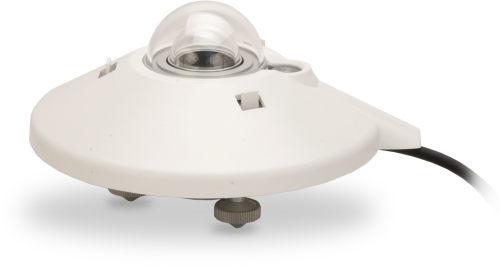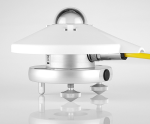This product is not available for new orders.

| Services Available |
|---|
Überblick
Das CMP6 ist ein ISO first-Class Pyranometer, das Solarstrahlung über das gesamte Spektrum erfasst. Es kann direkt an einem Campbell-Loger angeschlossen und wird z.B. für Umweltüberwachung, Meteorologie oder Erkundungsmessungen für Solaranlagen eingesetzt.
Lesen Sie mehrFunktionen und Vorteile
- Double glass dome and increased thermal mass improve performance, allowing it to have an ISO first-class classification
- Compatible with most Campbell Scientific data loggers
- Integrated bubble level is visible without removing sun shield
- Desiccant-filled drying cartridge prevents dew from forming on the inner sides of the domes
- Compatible with the CVF4 heater/ventilator that keeps the domes free from ice and dew
- Measures reflected solar radiation when inverted
- Provides measurements in direct sunlight, under plant canopies, when the sky is cloudy, and in artificial light
- Compatible with the CWS900-series interfaces, allowing it to be used in a wireless sensor network
Bilder








Zugehörige Produkte
Technische Beschreibung
The CMP6 measures solar radiation with a high-quality blackened thermopile protected by two glass domes. Its flat spectral sensitivity, from 285 to 2800 nm, makes it ideal for applications in natural sunlight, under plant canopies, in green houses or buildings, and inverted to measure reflected solar radiation.
A desiccant-filled drying cartridge prevents dew from forming on the inner sides of the CMP6's domes. Campbell Scientific also offers the CVF4 heater/ventilator that keeps its domes free from ice and dew.
The CMP6 includes a white snap-on sun shield that reduces the sensor's temperature. A bubble level and adjusting leveling screws enable the sensor to be leveled without using a leveling base.
The CMP6 produces a millivolt signal that is measured directly by a Campbell Scientific datalogger.
Kompatibel mit
Please note: The following shows notable compatibility information. It is not a comprehensive list of all compatible products.
Datenlogger
| Product | Compatible | Note |
|---|---|---|
| CR1000 (retired) | ||
| CR1000X (retired) | ||
| CR300 (retired) | ||
| CR3000 | ||
| CR310 | ||
| CR350 | ||
| CR6 | ||
| CR800 (retired) | ||
| CR850 (retired) |
Additional Compatibility Information
Mounting
The CMP6 has a bubble level and two leveling feet, which allow it to be leveled without using a leveling base. This pyranometer mounts to a mast, crossarm, or pole (1.0 in. to 2.1 in. OD) via the CM255 or CM255LS mounting stand. The CMP6 should be mounted away from all obstructions and reflective surfaces that might adversely effect the measurement.
Spezifikationen
| Sensor | High-quality blackened thermopile protected by two glass domes |
| Measurement Description | Monitors solar radiation for the full solar spectrum range |
| ISO Classification | Class B (first class) |
| Spectral Range | 285 to 2800 nm |
| Sensitivity | 5 to 20 μV W-1 m2 |
| Temperature Dependence of Sensitivity | < 4% (-10° to +40°C) |
| Response Time | < 18 s (95% of final value) |
| Zero Offset Due to Thermal Radiation | < 15 W/m2 (200 W/m2) |
| Non-Stability | < 1% (change/year) |
| Non-Linearity | < 1% (0 to 1000 W/m2) |
| Directional Error | < 20 W/m2 (up to 80° with 1000 W/m2 beam) |
| Tilt Error | < 1% |
| Level Accuracy | 0.1° |
| Impedance | 20 to 200 Ω |
| Operating Temperature Range | -40° to +80°C |
| Typical Signal Output | 0 to 20 mV (for atmospheric applications) |
| Maximum Irradiance | 2000 W/m2 |
| Expected Daily Uncertainty | < 5% |
| Dome Diameter | 5 cm (2 in.) |
| Width | 15 cm (5.9 in.) with shield |
| Height | 9.25 cm (3.64 in.) |
| Weight | 0.9 kg (2 lb) with 10.1 m (33 ft) cable |
FAQs für
Number of FAQs related to CMP6: 10
Alle anzeigenWenige anzeigen
-
A cable length of 300 ft can be used with the understanding that additional noise may be introduced into the measurement. Typically, in systems with pyranometers, the sensors are installed near the datalogger (within 50 ft). If an application requires long leads, contact Campbell Scientific for assistance.
-
No. These are all passive devices that create their own voltage signal as a response to the measurement being made. There is, however, a heater and ventilator for these sensors (CVF4-L) that requires a power supply.
-
Because of the loss of IR radiation, nearly all thermopile instruments typically have a negative offset. This offset is most easily visible at night-time, when a small negative value is read instead of zero. This same offset is present during the daytime, but it is not as visible because of the large solar signal.
Another common issue involves leveling an instrument. Leveling a thermopile instrument can cause errors in the direct beam component because the cosine response is not correct. These errors are more notable when the sun is close to the horizon because the angle is so shallow.
-
Most Campbell Scientific sensors are available as an –L, which indicates a user-specified cable length. If a sensor is listed as an –LX model (where “X” is some other character), that sensor’s cable has a user-specified length, but it terminates with a specific connector for a unique system:
- An –LC model has a user-specified cable length for connection to an ET107, CS110, or retired Metdata1.
- An –LQ model has a user-specified cable length for connection to a RAWS-P weather station.
If a sensor does not have an –L or other –LX designation after the main model number, the sensor has a set cable length. The cable length is listed at the end of the Description field in the product’s Ordering information. For example, the 034B-ET model has a description of “Met One Wind Set for ET Station, 67 inch Cable.” Products with a set cable length terminate, as a default, with pigtails.
If a cable terminates with a special connector for a unique system, the end of the model number designates which system. For example, the 034B-ET model designates the sensor as a 034B for an ET107 system.
- –ET models terminate with the connector for an ET107 weather station.
- –ETM models terminate with the connector for an ET107 weather station, but they also include a special system mounting, which is often convenient when purchasing a replacement part.
- –QD models terminate with the connector for a RAWS-F Quick Deployment Station.
- –PW models terminate with the connector for a PWENC or pre-wired system.
-
Not every sensor has different cable termination options. The options available for a particular sensor can be checked by looking in two places in the Ordering information area of the sensor product page:
- Model number
- Cable Termination Options list
If a sensor is offered in an –ET, –ETM, –LC, –LQ, or –QD version, that option’s availability is reflected in the sensor model number. For example, the 034B is offered as the 034B-ET, 034B-ETM, 034B-LC, 034B-LQ, and 034B-QD.
All of the other cable termination options, if available, are listed on the Ordering information area of the sensor product page under “Cable Termination Options.” For example, the 034B-L Wind Set is offered with the –CWS, –PT, and –PW options, as shown in the Ordering information area of the 034B-L product page.
Note: As newer products are added to our inventory, typically, we will list multiple cable termination options under a single sensor model rather than creating multiple model numbers. For example, the HC2S3-L has a –C cable termination option for connecting it to a CS110 instead of offering an HC2S3-LC model.
-
The ISO and WMO classify First Class pyranometers, such as the CMP6-L, as suitable for network operations. However, if accuracy is of paramount concern, consider using Secondary Standard pyranometers, such as the CMP11-L and CMP21-L, instead.
-
Yes. Each pyranometer is shipped with an instruction manual provided by Kipp & Zonen that contains information concerning its construction, spectral sensitivity, cosine response, and a simple sensor check out procedure. Included with the sensor and manual is a calibration certificate with the sensor sensitivity value and serial number.
-
All of these pyranometers measure the amount of solar short-wave radiation incident on a surface. Because of their accuracy and performance level, the CMP11-L and CMP21-L are classified by the International Organization for Standardization (ISO) and World Meteorological Organization (WMO) as Secondary Standard sensors, representing the highest level of measurements made by pyranometers. In comparison, the CMP6-L is classified as a First Class sensor, which is the middle classification for pyranometers. (Second Class is the lowest pyranometer classification.)
-
Many Campbell Scientific sensors are available with different cable termination options. These options include the following:
- The –PT (–PT w/Tinned Wires) option is the default option and does not display on the product line as the other options do. The cable terminates in pigtails that connect directly to a datalogger.
- In the –C (–C w/ET/CS110 Connector) option, the cable terminates in a connector that attaches to a CS110 Electric Field Meter or an ET-series weather station.
- In the –CWS (–CWS w/CWS900 Connector) option, the cable terminates in a connector that attaches to a CWS900-series interface. Connection to a CWS900-series interface allows the sensor to be used in a wireless sensor network.
- In the –PW (–PW w/Pre-Wire Connector) option, the cable terminates in a connector that attaches to a prewired enclosure.
- In the –RQ (–RQ w/RAWS Connector) option, the cable terminates in a connector that attaches to a RAWS-P Permanent Remote Automated Weather Station.
Note: The availability of cable termination options varies by sensor. For example, sensors may have none, two, or several options to choose from. If a desired option is not listed for a specific sensor, contact Campbell Scientific for assistance.
-
To incorporate a sensor that is compatible with wireless sensor interfaces into a wireless network, a CWS900-series wireless sensor interface is needed, as well as an A205 CWS-to-PC interface to configure it.

